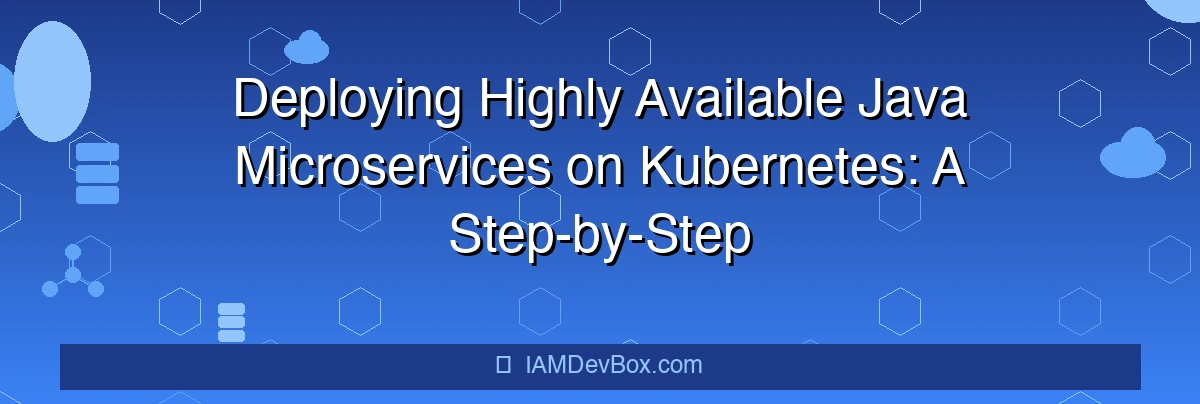Visual Overview:
graph TB
subgraph "Microservices Authentication"
Client[Client] --> Gateway[API Gateway]
Gateway --> Auth[Auth Service]
Auth --> TokenStore[(Token Store)]
Gateway --> ServiceA[Service A]
Gateway --> ServiceB[Service B]
Gateway --> ServiceC[Service C]
ServiceA --> ServiceB
ServiceB --> ServiceC
end
style Gateway fill:#667eea,color:#fff
style Auth fill:#764ba2,color:#fff
In today’s fast-paced digital environment, deploying Java microservices on Kubernetes has become a cornerstone for building scalable, resilient, and efficient applications. This guide will walk you through the process of deploying highly available Java microservices on Kubernetes, ensuring your applications are robust and capable of handling increased traffic and potential failures.
1. Understanding Kubernetes Basics
Before diving into deployment, it’s essential to grasp Kubernetes fundamentals. Pods, the smallest deployable units, are the building blocks of Kubernetes applications. Each pod encapsulates one or more containers, ensuring isolation and scalability.
2. Containerizing Java Microservices
The first step in deploying Java microservices on Kubernetes is containerization. Use Docker to package your Java application into an image. Here’s an example Dockerfile:
FROM openjdk:17-jdk
WORKDIR /app
COPY target/my-java-app.jar my-java-app.jar
EXPOSE 8080
CMD ["java", "-jar", "my-java-app.jar"]
This Dockerfile uses the OpenJDK 17 image, copies the JAR file, and sets the command to run the application.
3. Deploying with Kubernetes Deployments
To ensure high availability, use a Kubernetes Deployment to manage your pods. Here’s a sample deployment manifest:
apiVersion: apps/v1
kind: Deployment
metadata:
name: my-java-deployment
spec:
replicas: 3
selector:
matchLabels:
app: my-java-app
template:
metadata:
labels:
app: my-java-app
spec:
containers:
- name: my-java-container
image: /images/posts/deploying-highly-available-java-microservices-on-k-e3020377.webp
ports:
- containerPort: 8080
resources:
requests:
cpu: 250m
memory: 512Mi
limits:
cpu: 500m
memory: 1Gi
This manifest deploys three replicas of your Java application, ensuring availability and fault tolerance.
4. Exposing Services with Kubernetes Services
To make your microservices accessible within the cluster, define a Kubernetes Service. For external access, consider using a LoadBalancer or Ingress controller.
apiVersion: v1
kind: Service
metadata:
name: my-java-service
spec:
selector:
app: my-java-app
ports:
- protocol: TCP
port: 80
targetPort: 8080
type: LoadBalancer
This service exposes your application on port 80, accessible via an external load balancer.
5. Persistent Storage with PersistentVolumes
If your microservices require persistent storage, configure PersistentVolumes and PersistentVolumeClaims (PVCs). For example:
apiVersion: v1
kind: PersistentVolumeClaim
metadata:
name: my-pvc
spec:
accessModes:
- ReadWriteOnce
resources:
requests:
storage: 10Gi
This PVC requests 10Gi of storage, which Kubernetes provisions dynamically if using a cloud provider.
6. Networking and Security
Ensure secure communication using Kubernetes DNS for service discovery and Network Policies to restrict traffic. Example NetworkPolicy:
apiVersion: networking.k8s.io/v1
kind: NetworkPolicy
metadata:
name: my-network-policy
spec:
podSelector:
matchLabels:
app: my-java-app
ingress:
- from:
- podSelector:
matchLabels:
app: frontend
ports:
- protocol: TCP
port: 8080
This policy allows traffic only from pods labeled ‘frontend’ to your Java application.
7. Scaling and Autoscaling
Implement Horizontal Pod Autoscaler (HPA) to automatically scale pods based on CPU usage:
apiVersion: autoscaling/v2beta2
kind: HorizontalPodAutoscaler
metadata:
name: my-hpa
spec:
scaleTargetRef:
apiVersion: apps/v1
kind: Deployment
name: my-java-deployment
minReplicas: 3
maxReplicas: 10
metrics:
- type: Resource
resource:
name: cpu
target:
type: Utilization
averageUtilization: 50
This HPA scales your deployment between 3 and 10 pods based on CPU utilization.
8. Monitoring and Logging
Integrate monitoring tools like Prometheus and Grafana for insights into application performance. For logging, use the ELK stack (Elasticsearch, Logstash, Kibana) to collect and analyze logs.
9. Security Best Practices
Enhance security with Role-Based Access Control (RBAC) and encryption. Example RBAC role:
apiVersion: rbac.authorization.k8s.io/v1
kind: Role
metadata:
name: my-role
rules:
- apiGroups: [""]
resources: ["pods"]
verbs: ["get", "list", "watch"]
This role restricts access to pods, ensuring only authorized users can manage them.
10. Testing and Best Practices
Thoroughly test each component and the overall deployment. Follow best practices, such as using immutable deployments, keeping containers lightweight, and adhering to the Twelve-Factor App principles.
Conclusion
Deploying highly available Java microservices on Kubernetes involves containerization, deployment management, service exposure, persistent storage, networking, scaling, monitoring, and security. By following this guide, you can build a robust, scalable, and secure application infrastructure. Consider exploring real-world case studies and community solutions to further enhance your deployment strategy.
